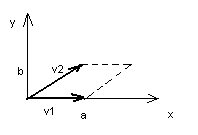ECE
5340/6340: Lecture 4 -- REVIEW OF MATRIX ALGEBRA
Why
matrix equations are important in numerical methods:

SIMULTANEOUS
EQUATIONS: are of the form
a11 x1 + a12
x2 + a13 x3 + … + a1n xn = b1
a21 x1 + a22
x2 + a23 x3 + … + a2n xn = b2
am1x1 + am2 x2
+ am3 x3 + … + amn
xn = bm
![]()
![]() Which can
be written as a matrix equation:
Which can
be written as a matrix equation:

![]()
![]()
![]()
![]()
![]()
![]()
![]()
![]()

MATRIX ADDITION:
![]() MATRIX TRANSPOSE:
MATRIX TRANSPOSE:

![]() INNER OR DOT PRODUCT
INNER OR DOT PRODUCT

VECTOR
DOT PRODUCT
p = v1·v2 = component of v1 in v2 direction = |v1||v2|cos(a)

(a = angle between vectors)
DETERMINANT
of a matrix (as it relates to matrix singularity)

4D: Repeat.
Method:
1) Find minor matrices by
striking row and column.
2) Multiply by element
3) Signs alternate +-+-+- …
Determinant: Defines the “hypervolume”
of a matrix.
2x2 : area
defined by parallelogram of matrix vectors
3x3 :
volume defined by parallelopiped of matrix vectors

![]()
![]()
![]()
![]()

·
If any two vectors become coincident (2D: parallel / 3D: in the same
plane), then the area or volume collapses to zero.
·
If you are solving 3 equations in 3 unknowns, you can only solve it if
your equations (vectors) are independent (not coincident).
·
Thus, if the determinant of the matrix is zero (or near zero), you
cannot solve the matrix equation.
·
This is called a “singular
matrix”.
DIAGONAL
MATRIX

IDENTITY
MATRIX

TRIANGULAR
MATRIX

DETERMINANT
OF PRODUCT OF MATRICES:
![]()
BANDED
MATRIX:

SPARSE
MATRIX:

VECTOR
CROSS PRODUCT
